The Build-up – ‘the wonderful’!
“We spend so much money on weddings”, sighed Mr. Singh. He might also have said: energy. An Indian wedding requires stamina from all concerned. An unceasing stream of ritual, prayer, blessings, dance and music. For days, our guesthouse in Bundi, Haveli Katkoun, had been filled with song. Family member from all over India had arrived and a happy chaos reigned. We were the only remaining paying guests – a tiny foreign enclave in a sea of Hindu ritual. Ladies began singing at 06.00 each morning, accompanied by the beat of a drum. “They are giving thanks to God for the marriage ceremony” the groom told me. Outside the front door an old man with a red turban played a pipe. I thought of him as the mad snake charmer. He was also accompanied by a drummer. Occasionally a young lad turned up to bang an even larger drum. All sounds blended together – a cacophony, one finished, another began; a round of rhythm and joy.
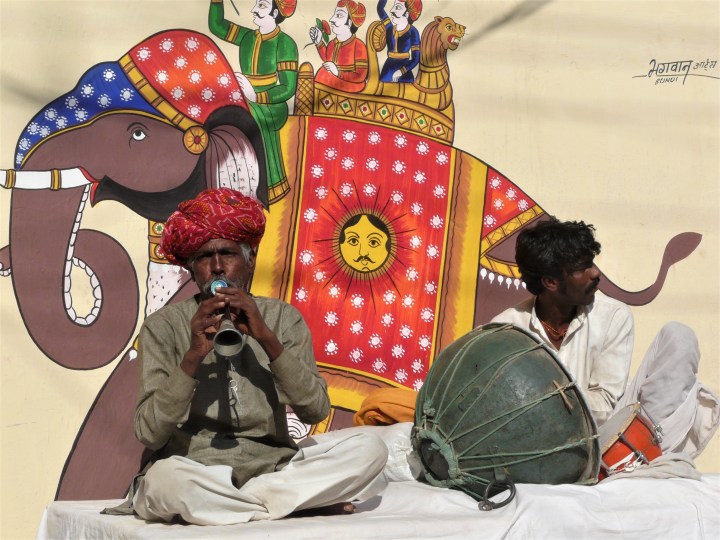
One evening a harmonium player played and sang – full throated, his deep resounding booming voice filled the courtyard. He was accompanied by a tabla and a cymbal player. The ladies of the family were at their very finest. Resplendent in vivid traditional Rajasthani dress – skirts and tunics embroidered with silver and gold thread. Jewellery covered their faces, heads, arms, ankles and toes. Gold cord decorated centre partings. Tassels hung from their arms. Each danced in turn, graceful arm movements, subtle gestures with the hands, small shrugs of the shoulders. Twirling, their skirts and tassels flared. Faces remained veiled. It was sensual and seductive. Bank notes were circled over the heads of the dancers and then given to the musicians. A row of rupee notes stood to attention along the front of the harmonium and others were wedged into the cords surrounding the drums.

On the eve of the wedding, the groom, wearing a long jacket, fitted trousers, and an orange turban with a diamante brooch pinned to it, sat cross-legged on a low platform, while the priest performed rituals and blessings. Family members placed a red tilak on his forehead and showered him with banknotes – symbolic offerings of happiness and prosperity. Then, as a brass band played on – a motley assortment of young and old men, wearing ill fitting, dirt stained uniforms – the groom mounted a decorated horse and rode at the head of a procession of family and friends. This time the men were also dressed up to the nines – brightly coloured turbans, with long loose ribbons of cloth flowing down their backs, frock coats, jodhpurs, gold chains, and pearls. Maharajas everyone! Not to be outdone, the women again wore every colour of the rainbow and huge amounts of gold. ‘All the women are dressed as brides’ a gentleman told us. The brass band walked with us. Bizarrely the procession was garlanded by eight or so young lads carrying electric strip lights, and enclosed by one more youth at the rear pulling a generator on a wooden cart! In a huge blast of noise and a blaze of light, the groom made his way to the temple and back to the guesthouse; but as the dancing continued he was forbidden entry. He would only set foot in his home again as a married man.




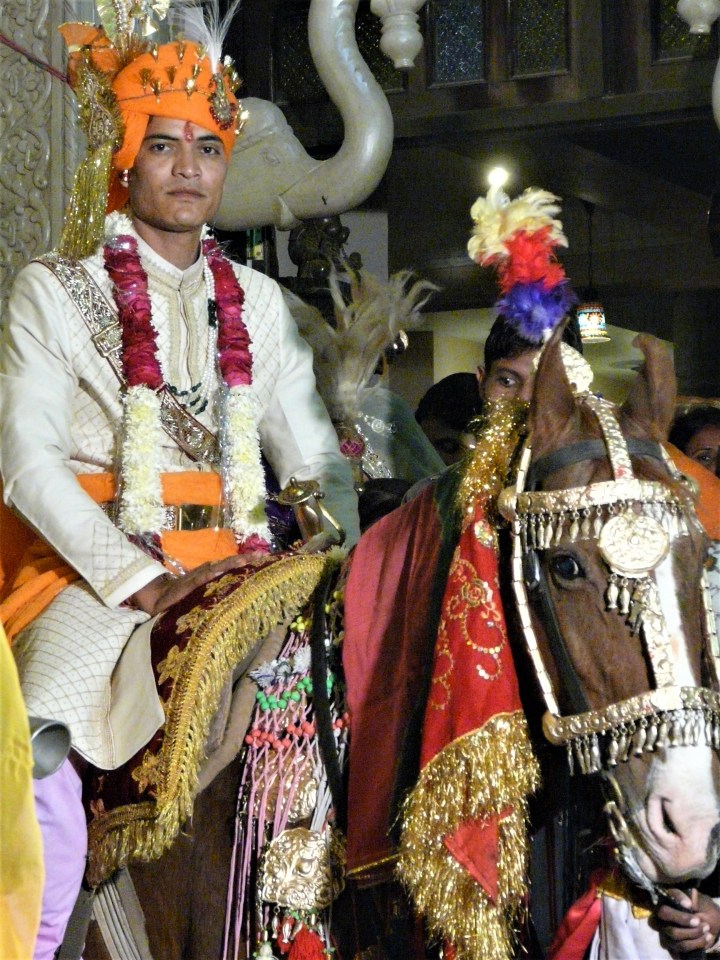
Off to Kota – ‘the weird’!
The ceremony took place in the bride’s hometown of Kota – about an hours journey from Bundi. None of the female members of the groom’s family were allowed to attend. We could never ascertain why – except – ‘it’s tradition’. I was an honorary man for the day, and was allowed to travel with the other 120 male family members.
Initially we were told that the coach to Kota would leave at lunchtime, so we were ready at 12.00. Then we were told it would be 15.00. We finally boarded the coach at 16.00 and left at 16.30. A coconut was cracked open under the wheel, and the splintered halves bought inside. Everyone gave a huge cheer and the coconut was shared out and eaten. We arrived at the venue – fully expecting the bridal party to greet us, but the place, a rather tatty resort hotel specialising in wedding parties, was deserted. Everyone headed off to various hotel rooms. We were bemused, confused, but the groom’s father insisted we also have a room. We were ushered into it and waited and waited and waited. Three long hours we sat there. Someone did bring around snacks – sweet and spicy mixed together on little tinfoil trays, potato crisps turning soggy in the syrup of the gulab jamun.*
Finally, after what seemed an eternity we ventured outside to find lots of people milling around in the garden. We walked amongst them – it was reminiscent of an old western movie, when the cowboy swings open the saloon doors, the pianist stops playing, and everyone falls silent – people stared – it was just curiosity, but all the same it was slightly unnerving.
By now it was well past nine in the evening and we were in need of sustenance. Long buffet tables loaded with silver tureens, groaning under the weight of vegetarian curries, dals, rice, vegetables, samosas and all manner of sickly sticky sweets, looked inviting. Everyone was eating, but oddly there was still no sign of the bride. We asked if we could eat – ‘yes’ nodded the man. We forgot that Indians have a habit of telling you what they think you want to hear! We were just heading over to the tables, plates in hand, when Mr. Singh caught up with us. He mumbled something about ‘the other side’. Confused, we made our way to the other end of the table, – maybe we were about to eat the food in the wrong order? Again, he rushed after us pointing to goodness knows where – finally it dawned on us as we heard him mutter something about ‘low caste people’ – we were at the wrong party – gate-crashers! Suitably shamefaced we followed him to the other side of a partition, to our ‘own’, upper-caste party. What a shame! Those ‘low caste’ people really knew how to eat; on our side of the fence there were only a few crisps and slices of cucumber – but copious amounts of meat and whiskey. Meat and strong drink is a characteristic of the Rajput (warrior) caste. Mr. Singh deposited us firmly at a table and again we waited. People chatted and joked, drank whisky, but there was still no sign of the bride – it was now approaching midnight!
Suddenly something was happening but it wasn’t the arrival of the bride. For some reason the procession of the previous evening was being re-enacted. The groom on a horse, the brass band, the boys with strip lights, and about 120 men – just like before, except this time the women were missing. And this time, instead of setting off down a small deserted backstreet in Bundi, the procession lurched out of the hotel onto the main Bundi-Kota highway, which even at this time of night was buzzing with huge trucks, hurtling along, lights flashing, horns blaring. We proceeded in a chaotic fashion for maybe 100 metres down the highway, then did a U-turn and came back to the hotel. Most of the men seemed unfazed by the juggernauts whizzing past a few centimetres away on the unlit highway. But then most of them had been drinking whisky solidly for 5 hours by this time.
At Last… the ceremony.
The bride appeared without fanfare. One minute she wasn’t there, the next she was. The groom was escorted to a small square stage in the garden. The bride, dressed in a red sari, according to tradition, took her place next to him. Her face covered by a sheer veil, a large golden tinsel decoration tied to one side of her head to obscure her face still further. Demure, her head bowed and her eyes downcast, she sat motionless for most of the ceremony. Not once did man and future wife exchange a word or even a glance. There was no expression of emotion at all. Indeed after a week long round of endless, intricate ritual and preparation, we were amazed that there was almost no-one present at the actual ceremony. None of the groom’s family members who’d travelled from Bundi – and only the bride’s parents and a handful of women from her side. Most of those present were photographers, video recorders, or us! Maybe the 120 men were in a back room drinking whisky. Maybe they were miffed because the bride had turned up 6 hours late, who knows.
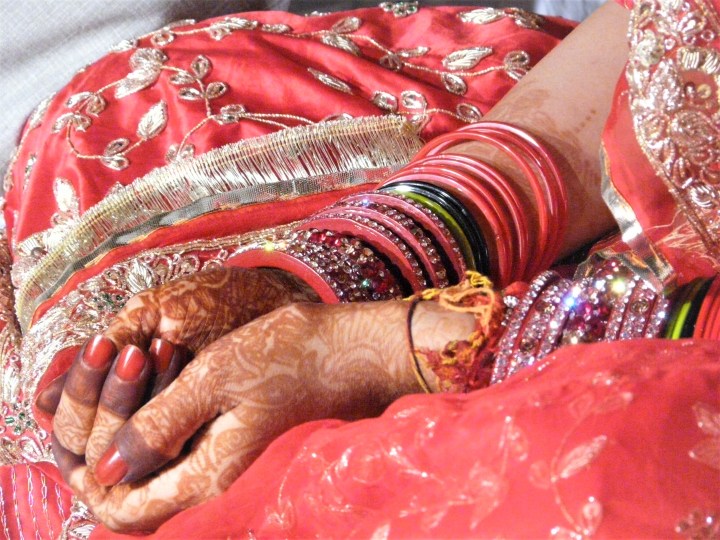
The ceremony lasted two hours. The priest looked like everybody’s idea of a guru. Long grey hair and straggly beard, dressed in a simple white sheet, and with a very serious yet serene expression. He chanted and intoned continuously – all in Sanskrit – a dead language which almost no-one can understand. But we watched and were moved by the various rituals – many involving the touching of hands and feet – gestures of respect and humility. The bride’s father ‘donated’ her to the groom – placing her right hand over the right hand of the groom. The left hands of both of her parents were placed under the couples hands, and their right hands on top. Gold, betelnut, flowers and fruit were then placed in the cupped hands. The bride and groom’s hands were tied together with an orange cloth. Hennaed hands, the clatter of bangles, painted nails, yellow turmeric rubbed into hand-palms – all this in the light of the sacred fire – flames casting an orange golden glow over faces, skin and clothes. The primary witness of any Hindu marriage is the fire deity or Agni – no Hindu marriage is deemed complete unless in it’s presence. Seven times the couple circled the fire, with each circuit making a specific vow to establish some aspect of a happy relationship and household for each other. The bride and groom then exchanged garlands of flowers – to signify their acceptance of each other as man and wife. Finally, a woman placed six rings on the bride’s toes. (Only a married woman can wear toe rings). It was official at last. By this time it was 2.30 a.m. and very cold. The priest picked up his crash helmet and sped off on his motorbike.

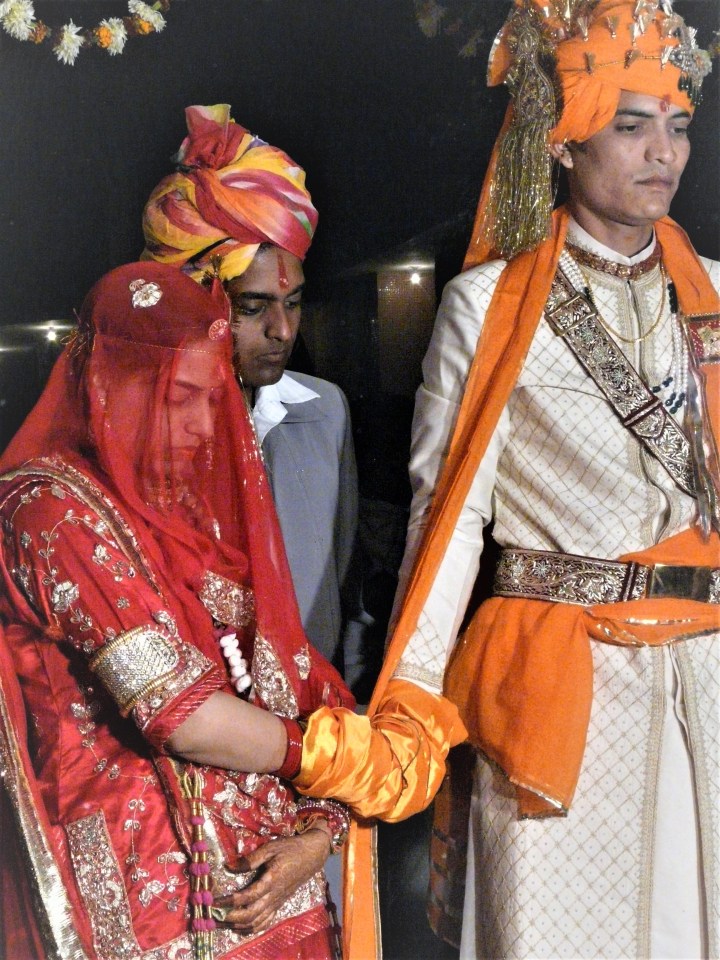

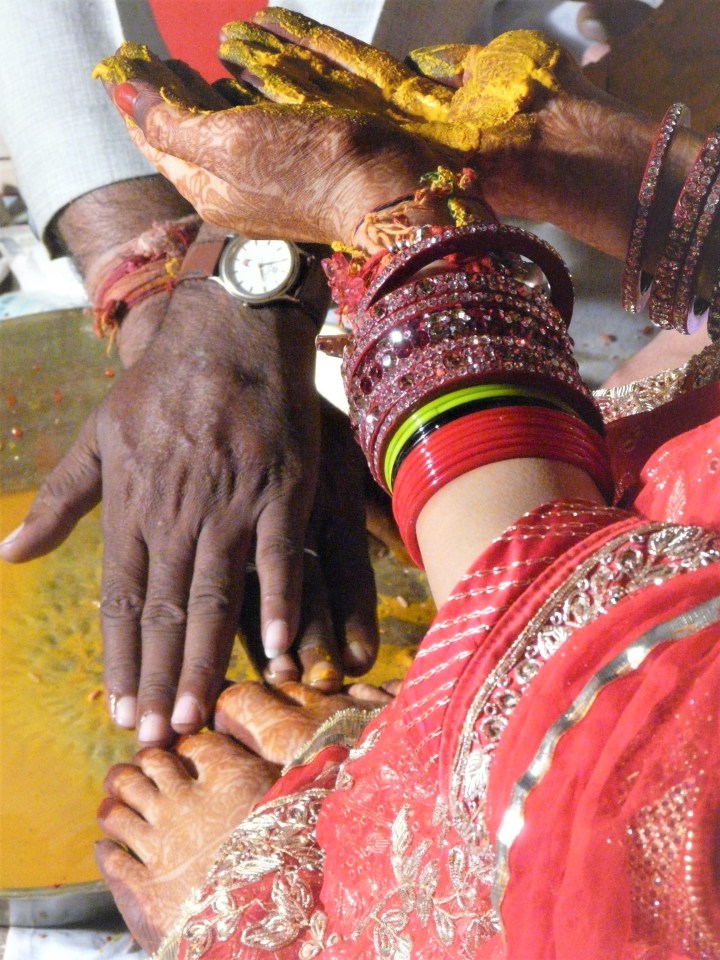
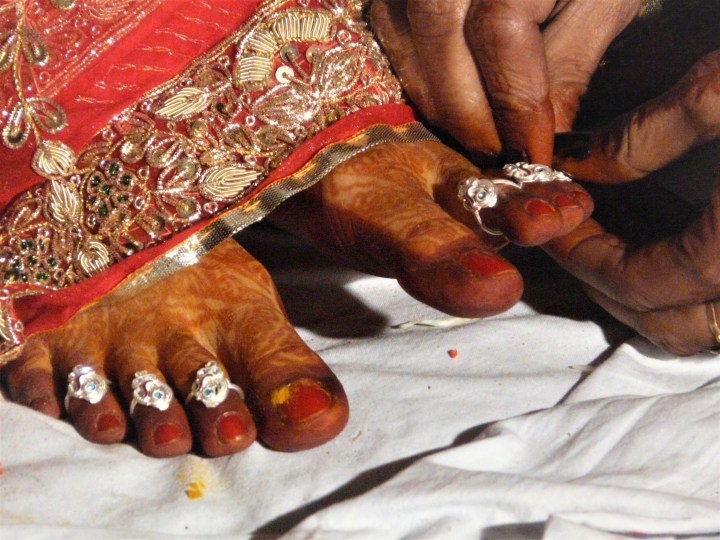
The Aftermath.
Exhausted, and now grateful for the fact that we’d been given a hotel room, we made our way inside. But there was someone asleep in our bed!! A gentle touch, and an ‘excuse me sir’ had absolutely no effect but a good rough shake did the trick. After he’d dressed and staggered away we lay down, fully clothed to try and catch a couple of hours sleep. (We had originally been told we’d be back in Bundi the same evening). A huge crash sounded from the bathroom. On investigation Jim saw the tail end of what he swears was a rat disappearing behind the washbasin! After that we slept with the light on.
What a week! What a wedding! Weird, wacky, wonderful!
* deep fried balls of dough soaked in rose flavoured syrup – delicious!
Such an interesting event, thank you for sharing 😊
Happy New Year!
LikeLike
Thanks for reading! And Happy New Year to you too, Christie.
LikeLike
Wow! That was exhausting just reading about it! I imagine the bride and groom were really glad when it was all over. I know I would be.
LikeLike
Yep, from where I was standing it looked more like an ordeal to be got through, than a celebration to enjoy!
LikeLike
Thus the expression “an Indian wedding” ~ the ongoing and never ending festivities. Love the detailed description of the wedding and really enjoyed all the beautiful photographs, especially the first one with the woman in lovely shades of orange and pink. What an extravaganza! Quite the experience. We have been in India many times but with regards to weddings we have only gate crashed for a few minutes a variety of them.. and been invited in, but stayed just a short while on a variety of occasions. Never have we gone full steam ahead as you just did. Bravo. How did you enjoy being an “honorary man” for a day? 🙂
Peta
LikeLike
It was a tad weird being an honorary man. I felt sorry for all the women from their own families who couldn’t go. It was a great experience, but I think one Indian wedding in a lifetime is enough!
LikeLike
Oh this is just brilliant! Fabulous photos, and I followed every word. I got caught up in a wedding in Agra – the procession with the groom in a huge carriage and the loud speakers, and everyone dancing as it all moved slowly along the street. We were invited to join in and also when we arrived at the venue. We waited and waited for the bride to appear but finally left because we had a very early start the next (ie that) morning. This completes the picture for me. Weird, wonderful, bizarre, and fabulous all rolled into one.
Alison
LikeLike
What an experience! This would make a great movie!
LikeLike
Ha ha! I’ll have to think up a suitable Hollywood actress to play me!
LikeLike
Awesome-sauce portrayal of Indian wedding through , alien perspective , but the representation in a chronological order is so perfect, that i also got astonished , by the way its an atypical marriage which is performed under all set rituals , and traditions , like where bride sari should be red in color , which symbolizes love and faith , there is ritual of applying turmeric which is applied on bride and as well as groom which signifies purity , fertility and good health, which u have shown in one of the photos , but eventually i would like to say portraits are adorable , and indirectly through the blog you have critique on Indian institution of marriage and its set rules But the representation is beautiful and incredible ! .
LikeLiked by 2 people
Thank you for your insights, adding a lot of info. about details which I didn’t know. There is so much I don’t understand in so many places, – things that really grab my interest with their colour and beauty – it’s nice to know something about the rituals.
LikeLiked by 1 person
Welcome dear , I like your post because it is full of information
LikeLiked by 1 person
Thanks so much for your comments.
LikeLike
More wonderful…😊
LikeLiked by 1 person